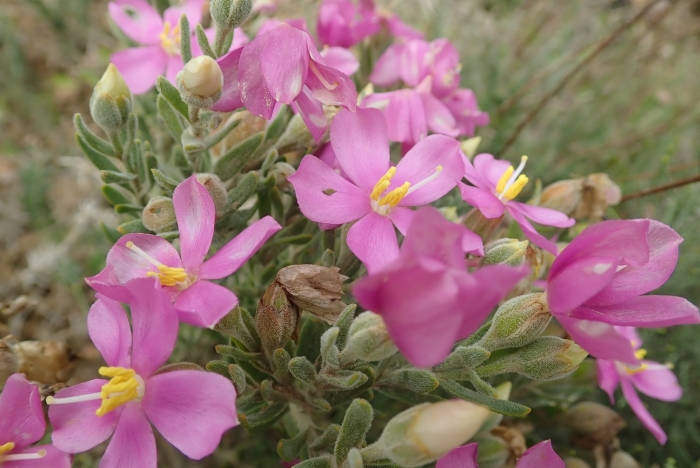Sea-Rose
(Orphium frutescens)
Sea-Rose (Orphium frutescens)
/
/

Peter Warren
Public Domain
Image By:
Peter Warren
Recorded By:
Copyright:
Public Domain
Copyright Notice:
Photo by: Peter Warren | License Type: Public Domain | License URL: http://creativecommons.org/publicdomain/zero/1.0/ | Rights Holder: Peter Warren | Publisher: iNaturalist | Date Created: 2020-01-29T12:03:07-08:00 |


























































Estimated Native Range
Summary
Orphium frutescens, commonly known as Sea-Rose, is an evergreen shrub native to coastal dunes and sandy shores of the Western Cape in South Africa. It typically grows to a height of 1-2 feet and a width of 0.8-1 feet. The genus name, Orphium, is inspired by the legendary Greek musician Orpheus, and the plant exhibits an erect subshrub form with virgately branched stems that are more or less pubescent and leafy to the apex. Its flowers are a vibrant candy pink, or rarely white, and are notable for their vivid yellow anthers, blooming in the warm months and attracting pollinators with their showiness.
Sea-Rose is valued for its striking flowers and its ability to thrive in coastal gardens where other plants might struggle due to salt spray and sandy soils. It is often used in rockeries, coastal plantings, and as a low-growing border plant. This shrub requires full sun exposure and well-drained soils, and while it tolerates medium amounts of water, it is also drought-resistant once established. Gardeners should note that the flowers are adapted for pollination by carpenter bees, which vibrate the blooms to release pollen, a mechanism known as buzz pollination. Therefore, in regions without these native pollinators, the plant may require hand pollination to produce seeds. Potential problems include root rot in poorly drained soils and susceptibility to pests when grown outside its native range.CC BY-SA 4.0
Sea-Rose is valued for its striking flowers and its ability to thrive in coastal gardens where other plants might struggle due to salt spray and sandy soils. It is often used in rockeries, coastal plantings, and as a low-growing border plant. This shrub requires full sun exposure and well-drained soils, and while it tolerates medium amounts of water, it is also drought-resistant once established. Gardeners should note that the flowers are adapted for pollination by carpenter bees, which vibrate the blooms to release pollen, a mechanism known as buzz pollination. Therefore, in regions without these native pollinators, the plant may require hand pollination to produce seeds. Potential problems include root rot in poorly drained soils and susceptibility to pests when grown outside its native range.CC BY-SA 4.0
Plant Description
- Plant Type: Shrub
- Height: 1-2 feet
- Width: 0.8-1.3 feet
- Growth Rate: Moderate
- Flower Color: Pink
- Flowering Season: Spring, Summer
- Leaf Retention: Evergreen
Growth Requirements
- Sun: Full Sun
- Water: Medium
- Drainage: Fast
Common Uses
Bee Garden, Border Plant, Butterfly Garden, Low Maintenance, Rock Garden, Showy Flowers
Natural Habitat
Coastal dunes and sandy shores of the Western Cape
Other Names
Common Names:
Scientific Names: , Orphium frutescens, Chironia frutescens, Chironia decussata, Chironia grandiflora, Chironia angustifolia, Chironia caryophylloides, Chironia frutescens var. angustifolia, Chironia frutescens var. glabra, Chironia frutescens var. hirsuta
GBIF Accepted Name: Orphium frutescens (L.) E.Mey.